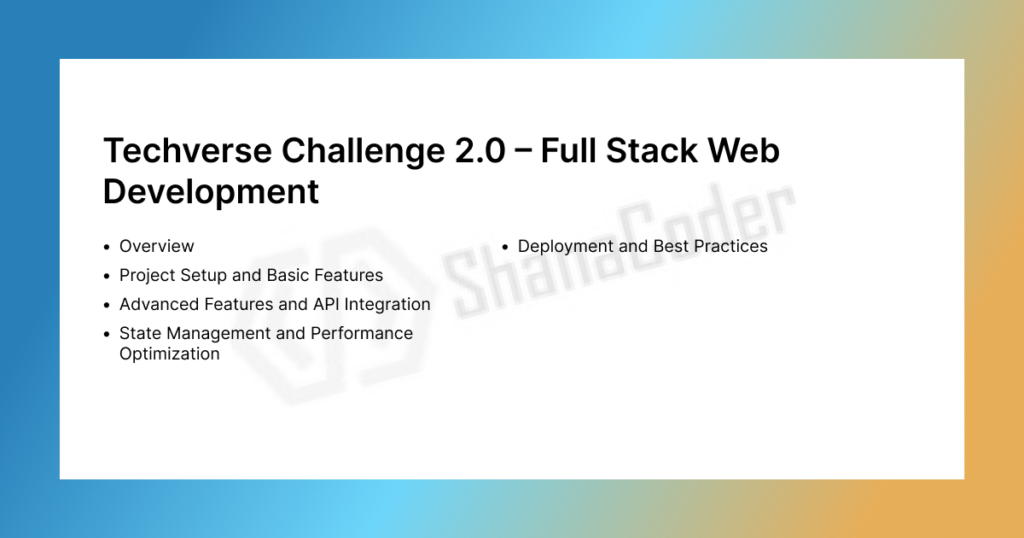Welcome to the Techverse Challenge 2.0! This GitHub-based challenge is tailored for developers eager to master Full Stack Web Development. Explore popular web development stacks, including MERN, MEAN, MEVN, Ruby on Rails, and PERN, and enhance your ability to build, understand, and transform web applications.
Overview
This challenge consists of four comprehensive sections:
- Project Setup and Basic Features
- Advanced Features and API Integration
- State Management and Performance Optimization
- Deployment and Best Practices
By completing these sections, you’ll gain in-depth knowledge of full stack web development and create a robust portfolio project.
Repository Contribution Guide
Fork the Repository
- Navigate to the repository page on GitHub.
- Click the “Fork” button to create a personal copy of the repository.
Choose a Stack
Select one of the full-stack options provided. For instance, the MERN stack includes MongoDB, Express.js, React.js, and Node.js.
Complete Each Section
- Organize your code within the directories corresponding to each section and stack.
- Document your code thoroughly, adhere to best practices, and ensure comprehensive testing.
Submit a Pull Request
- Push your completed code to your forked repository.
- Submit a pull request to the main repository.
- Include a detailed description of your changes and be ready to address feedback from maintainers.
Full Stack Options
MERN Stack
- Components: MongoDB, Express.js, React.js, Node.js
MEAN Stack
- Components: MongoDB, Express.js, Angular, Node.js
MEVN Stack
- Components: MongoDB, Express.js, Vue.js, Node.js
Ruby on Rails Stack
- Components: Ruby on Rails, PostgreSQL/MySQL, JavaScript/React.js/Vue.js
PERN Stack
- Components: PostgreSQL, Express.js, React.js, Node.js
Section 1: Project Setup and Basic Features
- Project Initialization:
- Create a new project using the chosen stack.
- Initialize version control with Git.
- Set up project structure and install dependencies.
- Basic CRUD Operations:
- Implement Create, Read, Update, Delete operations.
- Set up routing and error handling.
- User Authentication:
- Add sign-up, login, and logout features.
- Use JWT or session-based authentication.
- Protect routes with authentication middleware.
- Frontend Design:
- Develop a responsive frontend using the chosen stack’s framework or library.
- Utilize CSS frameworks or custom styles for better UI/UX.
Section 2: Advanced Features and API Integration
- Advanced CRUD Operations:
- Add pagination, filtering, and sorting capabilities.
- Update the frontend interface to reflect these features.
- API Integration:
- Work with third-party APIs (e.g., payment gateways, social media).
- Handle API responses and errors effectively.
- File Uploads:
- Implement secure file upload functionality.
- Use services like AWS S3 for storage if applicable.
- Real-Time Features:
- Add real-time capabilities using WebSockets or Socket.io.
- Implement live notifications or chat features.
Section 3: State Management and Performance Optimization
- State Management:
- Use tools like Redux, Vuex, or Context API for application-wide state.
- Structure and manage state effectively.
- Performance Optimization:
- Apply lazy loading and code splitting.
- Optimize backend database queries and indexing.
- Testing:
- Write unit and integration tests.
- Use testing tools like Jest, Mocha, or Cypress.
- Security Enhancements:
- Implement XSS protection, rate limiting, and input validation.
- Apply role-based access control and secure sensitive data.
Section 4: Deployment and Best Practices
- Deployment:
- Deploy your application to platforms like Heroku, AWS, or Vercel.
- Set up CI/CD pipelines for streamlined deployment.
- Documentation:
- Write detailed project documentation.
- Include API references, setup guides, and contribution instructions.
- Best Practices:
- Follow coding standards for readability and maintainability.
- Ensure scalability and modularity in your codebase.
- Feedback and Support:
- Create channels for user feedback.
- Monitor performance and address issues post-deployment.
Contribution Guidelines
- Fork this repository and create a new branch.
- Commit changes with clear and concise messages.
- Push your changes and submit a pull request.
Feedback and Support
For any queries or assistance, open an issue in the repository or participate in community discussions.
Start Building with Techverse Challenge 2.0
Embark on this journey to become a proficient full-stack developer. Build powerful web applications, collaborate with a community, and elevate your development skills!


